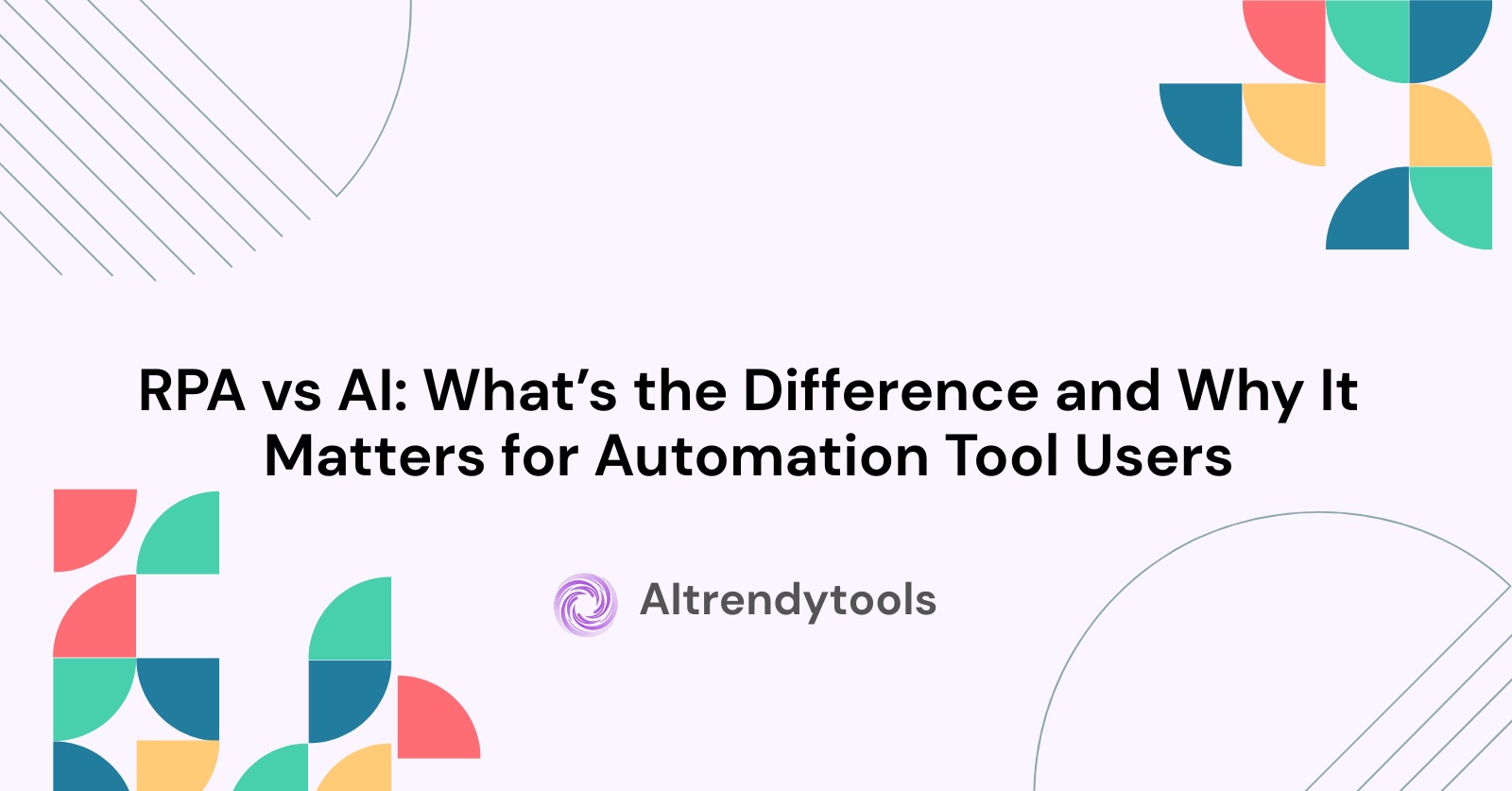🔥 AITrendytools: The Fastest-Growing AI Platform |
Write for usRPA vs AI: What’s the Difference and Why It Matters for Automation Tool Users
Discover the key differences between RPA and AI in automation. Learn when to use each technology, how they complement each other, and why understanding them helps you choose the right tools for your workflows.
Jul 23, 2025
Automation tools are everywhere. They promise faster workflows, fewer errors, and more time for high-value tasks. But with so many options, the differences between technologies often get blurred. Terms like Robotic Process Automation and Artificial Intelligence get tossed around as if they’re the same thing. They’re not.
Knowing how they differ helps avoid wasted effort. Some tools handle fixed, repetitive actions. Others adapt, learn, and respond to changing inputs. Confusing the two can lead to poor results and missed opportunities. Before choosing any automation solution, it’s worth understanding the line between rules and reasoning. That clarity drives better decisions.
RPA: A Digital Worker That Follows Rules
RPA is made to do repetitive tasks that follow simple, set rules. It mimics how a person interacts with software (clicking buttons, copying data, and filling out forms) without requiring an understanding of the content. That’s its strength. It does exactly what it’s told, every time.
Businesses utilize RPA to process invoices, transfer files between systems, update spreadsheets, and perform other tasks. These tasks don’t require judgment. They follow a script. As long as the process stays the same, RPA runs smoothly. It saves time, reduces human error, and keeps work consistent.
But that consistency has limits. RPA breaks when unexpected inputs show up or when a process changes too often. It doesn’t learn. It doesn’t adapt. It simply repeats instructions. That’s why understanding what RPA can and can’t do is the first step in choosing the right automation tools.
AI: A System That Learns and Adapts
AI handles complexity. It works with patterns, predictions, and decisions. Unlike RPA, which follows fixed steps, AI adjusts based on the data it receives. It doesn't need everything to be perfect or structured. That flexibility makes it useful for messy, unpredictable tasks.
AI shows up in tools that understand language, recognize images, or suggest actions. Think of customer service chatbots, fraud detection systems, or software that scans documents for meaning. These tools don’t follow a script. They respond based on training, experience, and feedback.
AI gets better the more it learns. The more data you give it, the smarter it becomes. But that comes with a cost. It can be harder to control, explain, or troubleshoot. That’s why it’s important to know when AI adds value and when it adds complexity.
RPA vs AI: Core Differences
RPA and AI serve different roles in automation. One repeats instructions. The other analyzes, learns, and improves. Understanding how they diverge helps users choose what to integrate in their digital strategy and one that fits their workflows.
Rules vs Learning
RPA relies on predefined rules to complete tasks the same way each time. It doesn’t adjust based on results. AI, in contrast, uses data patterns to make decisions, adapt, and improve. This difference shapes how each technology works and what level of flexibility it can handle.
Structured vs Unstructured Data
RPA works best with data that fits into specific formats, like spreadsheets or form fields. AI can handle messier inputs, such as emails, scanned documents, or spoken language. When data is unpredictable, AI thrives. When it’s clean and repeatable, RPA is the faster, more stable choice.
Speed vs Intelligence
RPA is optimized for speed and volume. It repeats actions quickly without interpretation. AI takes longer, but can deliver insight or personalization. Each has its place. Choose speed when the process is clear. Choose intelligence when context, nuance, or variation in behavior makes a difference.
Predictable vs Adaptive Tasks
RPA is perfect for tasks that rarely change. If the steps stay the same, it runs without fail. AI fits better when variation is expected or constant. It handles change, learns from it, and adjusts behavior. Your task environment determines which one brings real value.
Deployment Simplicity vs Technical Depth
RPA systems are usually easier to set up and maintain. They follow clear instructions and require minimal data. AI needs careful training, high-quality input, and ongoing adjustment. That complexity brings power but also risk. The choice depends on how much control, insight, and adaptability you need.
How RPA and AI Are Used in Automation Tools
Automation tools often promise intelligence, speed, and accuracy. But under the hood, they use different engines. Some rely entirely on RPA to follow rules. Others use AI to understand and respond. Knowing what powers a tool helps users avoid disappointment and choose the right fit for their needs.
RPA typically runs tasks that are structured and repetitive. It copies data from emails, fills out forms, moves files, or logs into systems to perform routine steps. These actions don’t change much. The strength of RPA lies in its precision. Once set up, it runs fast and doesn’t drift from the script.
AI works differently. It’s used when tasks require judgment, pattern recognition, or language understanding. A chatbot that responds to customers, a tool that scans contracts for key terms, or a system that detects unusual behavior in transactions—these all rely on AI. It improves by learning from data and feedback.
Combining RPA and AI: When It Makes Sense
Sometimes, one tool isn’t enough. You might need the speed and structure of RPA alongside the flexibility of AI. In those cases, combining them can create smoother workflows. But only when the use case truly demands both.
For example, AI can read a messy email, figure out what the customer wants, and extract key information. RPA can then take that data and enter it into a ticketing system, update a CRM, or trigger a workflow. AI interprets. RPA executes. This division works well when inputs are unpredictable, but the follow-up actions are fixed.
That doesn’t mean you always need both. Many businesses overcomplicate their systems by mixing tools when a simpler solution would do. Adding AI increases setup time, training needs, and troubleshooting. If your data is clean and your process stable, RPA alone might be enough.
The key is fit. Use AI when variation is high. Use RPA when the steps are clear. Use both only when the task needs both understanding and consistent execution. Get this wrong, and you’ll spend more for less. Get it right, and your automation becomes faster, smarter, and more reliable.
Wrapping Up
Choosing between RPA and AI isn’t a matter of preference. It’s a decision that shapes outcomes. Each has strengths, limits, and ideal use cases. For automation tool users, understanding the difference means avoiding false promises and making smarter investments.
Don’t let buzzwords blur your judgment. The real edge comes from knowing what you need, knowing what each tool delivers, and applying that knowledge with purpose and clarity.
🚀 Submit Your Tool to Our Comprehensive AI Tools Directory
Get your AI tool featured on our complete directory at AITrendytools and reach thousands of potential users. Select the plan that best fits your needs.





Join 30,000+ Co-Founders
Related Blogs
How AI May Change the Future of Online Casinos
Discover how AI is transforming online casinos with personalized gameplay, enhanced security, smarter marketing, and improved player protection.
Cash-Reward Gaming: Market Mechanics Meet Real-Time Play
Explore how cash-reward gaming merges market mechanics with real-time play, balancing payouts, risk, and engagement in a data-driven ecosystem.
The Next Wave of Fintech Tools: Smarter Spend Management Solutions
Discover the next wave of fintech spend management tools—real-time tracking, AI insights, and smarter controls for faster, clearer financial decisions.
Submit Your Tool to Our Comprehensive AI Tools Directory
List your AI tool on AItrendytools and reach a growing audience of AI users and founders. Boost visibility and showcase your innovation in a curated directory of 30,000+ AI apps.





Join 30,000+ Co-Founders

